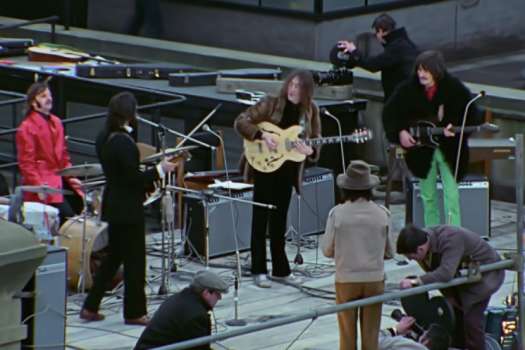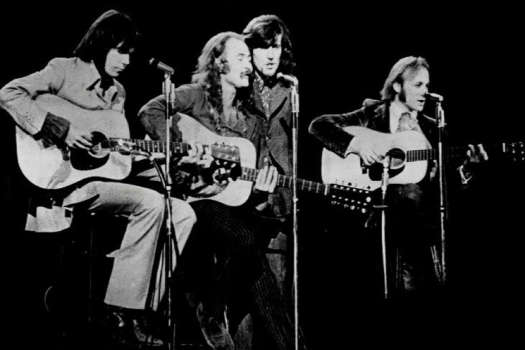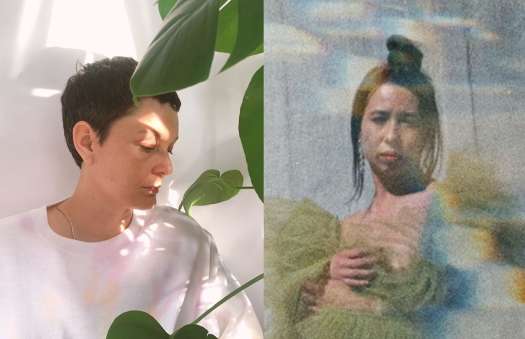Seeing as they were our year end cover stars and creators of Exclaim!'s favourite electronic album of 2008, it's easy to say this year was certainly Cut Copy's. Their sophomore album, In Ghost Colours, was a "psychedelic mixtape" (to use their words), a wonderful melting pot filled with shoegaze, electro, new wave, house, and most importantly the main ingredient: pure pop. The band's founder, songwriter, singer and visual artist Dan Whitford recalled a busy 2008 with us, while trying to relax in an airport lounge from an undisclosed location.
So you guys had quite a 2008. What do you think was different this year as opposed to when you released Bright Like Neon Love?
I think this time we just more of an opportunity to get out there and just play to more fans.
Were there any moments that stand out for you?
We had a really great response from Pitchfork for the album. We werent sure which way that was gonna go. And then playing Coachella for us was I guess a defining moment as far as seeing how the record was gonna go. We had a packed stage there and I think that really got the ball rolling for us. I think a lot of it had to do with word of mouth and the way information spreads through blogs and that sort of thing because it turned out to be a large difference compared to the last time we had a record out. Blogs are so much more powerful now; there seems to be more people checking them out and downloading music and sharing music via blogs - thats really helped people hear our music even before our record had come out.
What would you say you did differently with this record?
The main idea was to make music that was harder to define. And I guess that can be a problem sometimes when it comes to defining our own music because its quite difficult. We tried to make a record that didnt sound like a particular style, we write songs that transition from guitar-based stuff into more studio/club sounds, and theres even some folk-inspired stuff on this record. I guess this time around, with a similar intention as the first record to write pop songs and create something that interested us. I think probably we just got close to the kind of record we wanted to make this time around, and hopefully for the next one, again, as we learn better how to make records and write songs. We never started out with any kind of formal training, we taught ourselves everything. So each record for us sounds like were learning to make better art.
Have you noticed your audience expanding?
Definitely weve noticed, certainly in our country, a new audience for that kind of music, because I think people who were too young to actually go and buy tickets to our shows and go to bars to see us when the first record came out are now out their partying. Its almost like theyve adopted that type of music as their own, so it definitely feels like theres a subtle shift in the music that young people are into. In the last few years thats made things a lot better for us. Its a readymade audience for us this time, whereas with the first record we felt like we were battling to get a crowd or battling to get people to understand the kind of music were making, and this time it felt like people just got it straight away.
So, you feel that your music is more accessible in the current market? Where do you think that all changed?
It always felt like dance music and guitar-based music were always separate. Dance music was always kind of minimal and more of a niche thing, whereas now it feels like the two converge a lot more. Dance music is a lot more poppy, with more "regular song structures, than it was ten years ago. Maybe its a reflection of that, and why our music is more palatable.
People cant but help associate you guys to the 80s. Obviously its the synthesizers that do it in your music, but your merchandise uses a good deal of inspiration from that decade, the Run-DMC T-shirt homage, for instance. Are you as inspired by the 80s as everyone thinks you are?
Im more inspired by researching music from the 70s and even the early 90s than I am about the 80s, just because I grew up in the 80s and thats almost second nature. But for me, I find late 70s music, like pop and disco to be inspirational than the 80s stuff. But I think part of the reason people talk about the 80s when it comes to us is because they were writing pop songs, love songs with synthesizers, and thats the most obvious connection to that period.
So, what bands would be influential on your music then? Duran Duran? New Order?
Not so much Duran Duran theyre slightly more hedonistic and trashy than how we see ourselves. New Order had a very strong design image, but they also had really great songs with synths and guitars, the sort of thing that we would identify with. Or the Human League, if were talking more about straight pop music.
Since you have such an accomplished design background, does being responsible for the bands visuals and artwork help you fulfil your other passion?
Ive always had that creative control over the visual side of Cut Copy that is displayed out there in the marketplace. Its funny because its one of those things you dream about when youre in design school, doing artwork for CDs and vinyl, so getting the opportunity to do that is a dream come true. Often the artwork will explain some of the references in the music or the background of what the songs are about. I think it happens at the same time, the research you do for making music and the research for the visual side of things intertwine. I see the music as more than sitting down and learning the scales and writing some chords; its as much about broader culture as it is about physically making a song. Theres just so much in modern music thats kind of referential and post-modern, all of these styles, like how were influenced by all of these different eras of music. So, for me I think in that sense the songs are about more than just being songs themselves. There is a cultural significance that is ties into the visual aspect as well and the way that records look, so its a big part of the thing that were creating is as much visual as it is musical.
Finally, in doing my research I discovered that Cut Copy must have broken some sort of record for giving interviews this year. Does it feel like that to you?
Dont take offense to this but we were just sitting in an airline lounge right now ordering some food, and our tour manager came up and said I had to do an interview. And Ben, our bass player who just started playing with us this year said, "Yknow, I think I could actually do this interview and answer all of the questions correctly. Because weve done so many and hes heard them all, its almost to the point where we already have the answers to any possible question you could ask about the record or us weve answered them at least five or six times already. But to your credit, you actually asked a few questions that Ive never heard before, so Im glad I didnt give the phone to Ben.
So you guys had quite a 2008. What do you think was different this year as opposed to when you released Bright Like Neon Love?
I think this time we just more of an opportunity to get out there and just play to more fans.
Were there any moments that stand out for you?
We had a really great response from Pitchfork for the album. We werent sure which way that was gonna go. And then playing Coachella for us was I guess a defining moment as far as seeing how the record was gonna go. We had a packed stage there and I think that really got the ball rolling for us. I think a lot of it had to do with word of mouth and the way information spreads through blogs and that sort of thing because it turned out to be a large difference compared to the last time we had a record out. Blogs are so much more powerful now; there seems to be more people checking them out and downloading music and sharing music via blogs - thats really helped people hear our music even before our record had come out.
What would you say you did differently with this record?
The main idea was to make music that was harder to define. And I guess that can be a problem sometimes when it comes to defining our own music because its quite difficult. We tried to make a record that didnt sound like a particular style, we write songs that transition from guitar-based stuff into more studio/club sounds, and theres even some folk-inspired stuff on this record. I guess this time around, with a similar intention as the first record to write pop songs and create something that interested us. I think probably we just got close to the kind of record we wanted to make this time around, and hopefully for the next one, again, as we learn better how to make records and write songs. We never started out with any kind of formal training, we taught ourselves everything. So each record for us sounds like were learning to make better art.
Have you noticed your audience expanding?
Definitely weve noticed, certainly in our country, a new audience for that kind of music, because I think people who were too young to actually go and buy tickets to our shows and go to bars to see us when the first record came out are now out their partying. Its almost like theyve adopted that type of music as their own, so it definitely feels like theres a subtle shift in the music that young people are into. In the last few years thats made things a lot better for us. Its a readymade audience for us this time, whereas with the first record we felt like we were battling to get a crowd or battling to get people to understand the kind of music were making, and this time it felt like people just got it straight away.
So, you feel that your music is more accessible in the current market? Where do you think that all changed?
It always felt like dance music and guitar-based music were always separate. Dance music was always kind of minimal and more of a niche thing, whereas now it feels like the two converge a lot more. Dance music is a lot more poppy, with more "regular song structures, than it was ten years ago. Maybe its a reflection of that, and why our music is more palatable.
People cant but help associate you guys to the 80s. Obviously its the synthesizers that do it in your music, but your merchandise uses a good deal of inspiration from that decade, the Run-DMC T-shirt homage, for instance. Are you as inspired by the 80s as everyone thinks you are?
Im more inspired by researching music from the 70s and even the early 90s than I am about the 80s, just because I grew up in the 80s and thats almost second nature. But for me, I find late 70s music, like pop and disco to be inspirational than the 80s stuff. But I think part of the reason people talk about the 80s when it comes to us is because they were writing pop songs, love songs with synthesizers, and thats the most obvious connection to that period.
So, what bands would be influential on your music then? Duran Duran? New Order?
Not so much Duran Duran theyre slightly more hedonistic and trashy than how we see ourselves. New Order had a very strong design image, but they also had really great songs with synths and guitars, the sort of thing that we would identify with. Or the Human League, if were talking more about straight pop music.
Since you have such an accomplished design background, does being responsible for the bands visuals and artwork help you fulfil your other passion?
Ive always had that creative control over the visual side of Cut Copy that is displayed out there in the marketplace. Its funny because its one of those things you dream about when youre in design school, doing artwork for CDs and vinyl, so getting the opportunity to do that is a dream come true. Often the artwork will explain some of the references in the music or the background of what the songs are about. I think it happens at the same time, the research you do for making music and the research for the visual side of things intertwine. I see the music as more than sitting down and learning the scales and writing some chords; its as much about broader culture as it is about physically making a song. Theres just so much in modern music thats kind of referential and post-modern, all of these styles, like how were influenced by all of these different eras of music. So, for me I think in that sense the songs are about more than just being songs themselves. There is a cultural significance that is ties into the visual aspect as well and the way that records look, so its a big part of the thing that were creating is as much visual as it is musical.
Finally, in doing my research I discovered that Cut Copy must have broken some sort of record for giving interviews this year. Does it feel like that to you?
Dont take offense to this but we were just sitting in an airline lounge right now ordering some food, and our tour manager came up and said I had to do an interview. And Ben, our bass player who just started playing with us this year said, "Yknow, I think I could actually do this interview and answer all of the questions correctly. Because weve done so many and hes heard them all, its almost to the point where we already have the answers to any possible question you could ask about the record or us weve answered them at least five or six times already. But to your credit, you actually asked a few questions that Ive never heard before, so Im glad I didnt give the phone to Ben.




